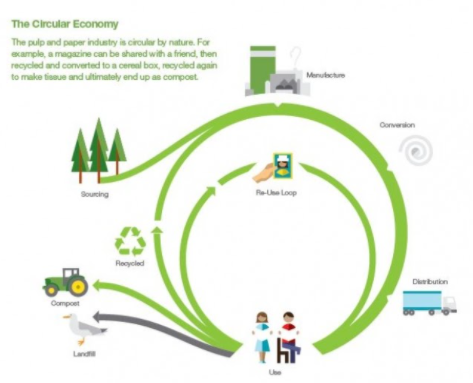For graphics head over to the Gallery.
Linear Economy – A linear economy traditionally follows the “take-make-dispose” step-by-step plan. This means that raw materials are collected, then transformed into products that are used until they are finally discarded as waste. Value is created in this economic system by producing and selling as many products as possible.
Take Make Waste – A term often related to linear economy.
Circular Economy – A circular economy is “a model of production and consumption, which involves sharing, leasing, reusing, repairing, refurbishing and recycling existing materials and products as long as possible” that aims at tackling global challenges like climate change, biodiversity loss, waste, and pollution

Compostable: Compostable is used to describe a product that can disintegrate into non-toxic, natural elements. It also does so at a rate consistent with similar organic materials. Compostable products require microorganisms, humidity, and heat to yield a finished compost product (CO2, water, inorganic compounds, and biomass).
Compostable materials on the market today take over 90 days to break down. YYC and all other waste and recycle programs in North America only allow 45 days for the product to be broken down then it gets sifted and put into the landfill. We have not seen a product on the market today that is compostable through the city system.
Reusable Packaging: Refers to packaging that has been conceived, designed and placed on the market to accomplish within its life cycle multiple trips or rotations by being refilled or reused for the same purpose for which it was conceived (DIRECTIVE (EU) 2018/852).
Reusable Packaging Cycles: The number of times a reusable packaging is used throughout its lifetime is referred to as “cycles”. Emissions, CO2 emissions and Global Warming Potential (GWP): In this report, environmental impacts are also referred to as emissions or CO2 emissions. This is because Global Warming Potential is used as the main impact indicator since it allows the conversion of any greenhouse gas emissions (responsible for global warming) into CO2 equivalent emissions.
Recycled content: Recycled content refers to the percentage of recycled post-consumer waste used in the production of certain packaging. For e.g. glass bottles are usually produced partly from virgin material, and partly from recycled glass. If a glass bottle has 35% recycled content, it means that it was produced from 65% virgin glass and 35% recycled glass.
Recycling Credit: The recycling of products provides environmental benefits since instead of just disposing of waste, we are generating a valuable recycled material that will avoid the need for virgin material. These benefits are referred to as “recycling credits” and can be attributed to the product being recycled, or/and the product using the recycled material.
Backhaul: Refers to the return trip(s), or in other words, the transport of the packaging after being used, back to retailer and/or producer which will make possible that the packaging is cleaned and reinserted in the production line to be reused.
Wish-cycling: When you throw stuff into the blue and green bin and hope it gets recycled to ease your conscience.
Earth-aware: Can be used in content when describing someone that is conscious of the environment but not used too often to avoid confusion with Earthware.
Return-for-reuse vs. reusable: There is some confusion with these terms.
Return-for-Reuse – You return the reusable containers to Earthware by dropping it off at select bottle depots OR arranging a pick up through the bottle depot or your favourite charity.
Reusable – Some think you can reuse Earthware containers in your own kitchen. You can but these are high quality containers and we need them back so we can use them dozens more times!
Recycle – We will eventually recycle our containers but let us make that decision. Keep returning your containers to the bottle depots so we can use them again until we retire them and recycle properly. If your container is broken or cracked please then recycle them. At the bottle depot if they discover the containers are broken they will properly recycle them as well.
AC Aseptic Carton
ADP Abiotic Depletion Potential
AP Acidification Potential
CSU Conventional Single-Use
EP Eutrophication Potential
GWP Global Warming Potential
HDPE High-Density Polyethylene
LCA Life Cycle Assessment
LDPE Low-Density Polyethylene
LSU Lightweight Single-Use
ODP Ozone Layer Depletion
PET Polyethylene Terephthalate
POCP Photochemical Ozone Creation
PP Polypropylene
RAD Radioactive Radiation
RFG Refillable Glass
RP Reusable Packaging
SU or SUP Single-Use, Single-Use Packaging
Single-use – always hyphenated
Takeout – one word
Pick up
“Pickup” (one word) is a noun, such as a truck, or an adjective, such as an impromptu round of something. You can ride in your pickup, or you can assemble a pickup band. You can tell your friend the plan for the package pickup, or you could have an impromptu round of pickup basketball.
“Pick up” (two words) is the verb form. You can pick up the package when your pickup truck arrives at your destination.
“Pick-up” (hyphenated) is a little glimpse of word evolution in action. When words change their forms, hyphenation is often stage one of their transformation. For example, “electronic mail” became “e-mail.” But as these words become more accepted, the hyphen is generally dropped, as is the case with “email” today. “Pick-up” can still be found with that hyphen in place, but it isn’t necessary anymore. Call it quaint, nostalgic (here’s looking at you, Pick-up Sticks), or verbose (if punctuation could be considered verbose), but when this “pick-up” form is used, remember it’s always as the noun or adjective form.